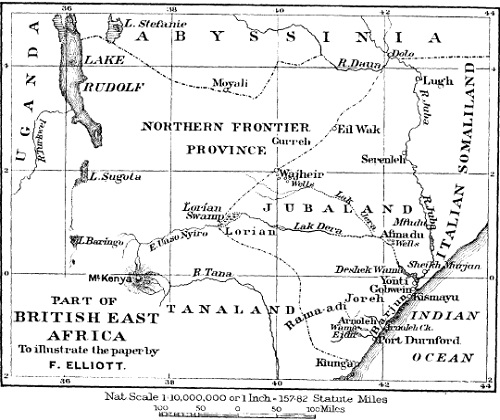The Lorian district is populated by the Talamuga Ogaden Somali, and the Borana, yet thinly owing to want of rain and the number of places abounding in tsetse fly. In other respects it is similar to the Afmadu district.

Of the tribes in Jubaland the Somali are by far the most important. In the whole of East Africa there are two branches of the Somali, the Darud [Darood] and the Ishaak. The former only is represented in Jubaland. The Dirr and Haweyeh tribes, largely represented in Italian territory and slightly in Jubaland, though called Somali are really the aborigines of the Benidir coast, and are in no way co-tribal with the Somali, with whom they seldom intermarry.
The Somali report that about 700 years ago an Arab sheik, Ismail Juberti by name, having been outlawed, fled from his country in a dhow. He landed on the Benidir coast near Hobia (or Obbia), but the Haweyeh, who then lived in the neighbourhood, refused him hospitality, so eventually he joined the Dirr tribe. From this tribe he married a wife by whom he had five sons. From one of these, named Darud [Darood] Juberti, the Darud Somali are descended. The Marehan Somali claim to be descended from Essa [Sade], a son of the above-named Darud Juberti; while the Herti [Harti] and Ogaden Somali claim descent from Kablalla Darud, another of his sons.
The Marehan, Ogaden, and Herti Somali are all strongly represented in Jubaland.
The Marehan tribe occupy the north-east part in the neighbourhood of Serenleh and Dolo. From Italian territory they have emigrated into Jubaland during the last twenty years, and are still inclined to be turbulent. They are possessors of large numbers of camels, and of horses also in lesser number, but, unlike the Ogaden, they do not rear cattle extensively. Probably their numbers do not exceed 5000.
The Herti Somali occupy the coast and extend inland as far as the Deshek Wama. Of the three sub-tribes of the Herti, the Midjertein [Majeerteen] are the most numerous in Jubaland, while the Wasengeleh are but few in number and the Dolbahanta still remain to the east of the Juba. The Herti do business as traders as well as rear cattle. Their numbers are about 3000.